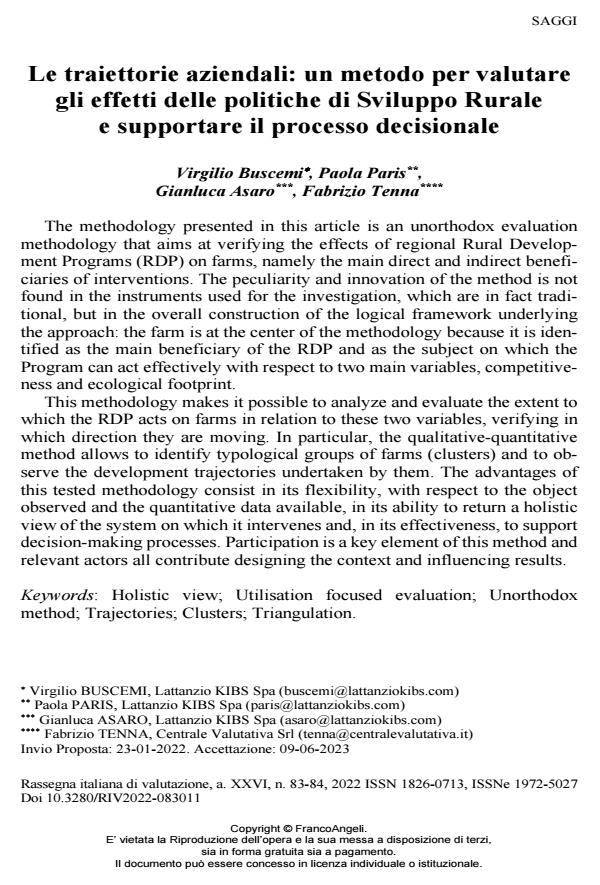Le traiettorie aziendali: un metodo per valutare gli effetti delle politiche di Sviluppo Rurale e supportare il processo decisionale
Journal title RIV Rassegna Italiana di Valutazione
Author/s Virgilio Buscemi, Paola Paris, Gianluca Asaro, Fabrizio Tenna
Publishing Year 2023 Issue 2022/83-84
Language Italian Pages 25 P. 199-223 File size 388 KB
DOI 10.3280/RIV2022-083010
DOI is like a bar code for intellectual property: to have more infomation
click here
Below, you can see the article first page
If you want to buy this article in PDF format, you can do it, following the instructions to buy download credits

FrancoAngeli is member of Publishers International Linking Association, Inc (PILA), a not-for-profit association which run the CrossRef service enabling links to and from online scholarly content.
The methodology presented in this article is an unorthodox evalua-tion methodology that aims at verifying the effects of regional Rural Development Programs (RDP) on farms, namely the main direct and indirect beneficiaries of interventions. The peculiarity and innovation of the method is not found in the instruments used for the investiga-tion, which are in fact traditional, but in the overall construction of the logical framework underlying the approach: the farm is at the center of the methodology because it is identified as the main beneficiary of the RDP and as the subject on which the Program can act effectively with respect to two main variables, competitiveness and ecological foot-print. This methodology makes it possible to analyze and evaluate the ex-tent to which the RDP acts on farms in relation to these two variables, verifying in which direction they are moving. In particular, the qualita-tive-quantitative method allows to identify typological groups of farms (clusters) and to observe the development trajectories undertaken by them. The advantages of this tested methodology consist in its flexibil-ity, with respect to the object observed and the quantitative data avail-able, in its ability to return a holistic view of the system on which it in-tervenes and, in its effectiveness, to support decision-making process-es. Participation is a key element of this method and relevant actors all contribute designing the context and influencing results.
Keywords: Holistic view; Utilisation focused evaluation; Unorthodox method; Trajectories; Clusters; Triangulation
Virgilio Buscemi, Paola Paris, Gianluca Asaro, Fabrizio Tenna, Le traiettorie aziendali: un metodo per valutare gli effetti delle politiche di Sviluppo Rurale e supportare il processo decisionale in "RIV Rassegna Italiana di Valutazione" 83-84/2022, pp 199-223, DOI: 10.3280/RIV2022-083010